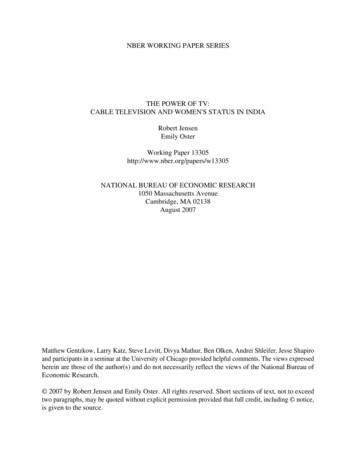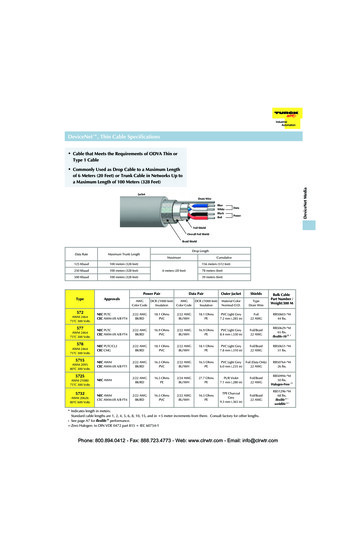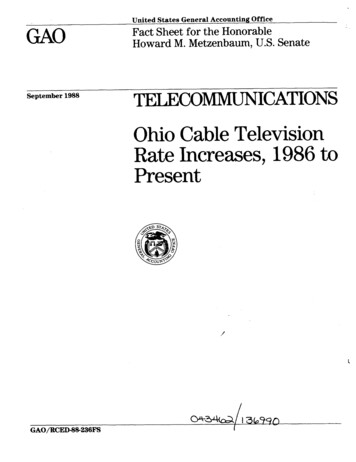
Transcription
NBER WORKING PAPER SERIESTHE POWER OF TV:CABLE TELEVISION AND WOMEN'S STATUS IN INDIARobert JensenEmily OsterWorking Paper 13305http://www.nber.org/papers/w13305NATIONAL BUREAU OF ECONOMIC RESEARCH1050 Massachusetts AvenueCambridge, MA 02138August 2007Matthew Gentzkow, Larry Katz, Steve Levitt, Divya Mathur, Ben Olken, Andrei Shleifer, Jesse Shapiroand participants in a seminar at the University of Chicago provided helpful comments. The views expressedherein are those of the author(s) and do not necessarily reflect the views of the National Bureau ofEconomic Research. 2007 by Robert Jensen and Emily Oster. All rights reserved. Short sections of text, not to exceedtwo paragraphs, may be quoted without explicit permission provided that full credit, including notice,is given to the source.
The Power of TV: Cable Television and Women's Status in IndiaRobert Jensen and Emily OsterNBER Working Paper No. 13305August 2007JEL No. J13,J16,O12,O33ABSTRACTCable and satellite television have grown rapidly throughout the developing world. The availabilityof cable and satellite television exposes viewers to new information about the outside world, whichmay affect individual attitudes and behaviors. This paper explores the effect of the introduction ofcable television on gender attitudes in rural India. Using a three-year individual-level panel dataset,we find that the introduction of cable television is associated with improvements in women's status.We find significant increases in reported autonomy, decreases in the reported acceptability of beatingand decreases in reported son preference. We also find increases in female school enrollment and decreasesin fertility (primarily via increased birth spacing). The effects are large, equivalent in some cases toabout five years of education in the cross section, and move gender attitudes of individuals in ruralareas much closer to those in urban areas. We argue that the results are not driven by pre-existing differentialtrends. These results have important policy implications, as India and other countries attempt to decreasebias against women.Robert JensenWatson Institute for International StudiesBrown UniversityBox 1970Providence, RI 02912and NBERRobert Jensen@harvard.eduEmily OsterUniversity of ChicagoDepartment of Economics1126 East 59th StreetChicago, IL 60637and NBEReoster@uchicago.edu
The Power of TV: Cable Television and Women’s Status in IndiaRobert JensenWatson Institute for International Studies, Brown University and NBEREmily Oster University of Chicago and NBERJuly 30, 2007AbstractCable and satellite television have grown rapidly throughout the developing world. Theavailability of cable and satellite television exposes viewers to new information about the outsideworld, which may affect individual attitudes and behaviors. This paper explores the effect of theintroduction of cable television on gender attitudes in rural India. Using a three-yearindividual-level panel dataset, we find that the introduction of cable television is associated withimprovements in women’s status. We find significant increases in reported autonomy, decreases inthe reported acceptability of beating and decreases in reported son preference. We also findincreases in female school enrollment and decreases in fertility (primarily via increased birthspacing). The effects are large, equivalent in some cases to about five years of education in thecross section, and move gender attitudes of individuals in rural areas much closer to those inurban areas. We argue that the results are not driven by pre-existing differential trends. Theseresults have important policy implications, as India and other countries attempt to decrease biasagainst women.1IntroductionThe growth of television in the developing world over the last two decades has been extraordinary.Estimates suggest that the number of television sets in Asia has increased more than six-fold, from100 million to 650 million, since the 1980s (World Press Review, 2003). In China, television exposuregrew from 18 million people in 1977 to 1 billion by 1995 (World Press Review, 2003). In more recentyears, satellite and cable television availability has increased dramatically. Again, in China, thenumber of people with satellite access increased from just 270,000 in 1991 to 14 million by 2005.Further, these numbers are likely to understate the change in the number of people for whomtelevision is available, since a single television is often watched by many.Beyond providing entertainment, television vastly increases both the availability ofinformation about the outside world and exposure to other ways of life, particularly in otherwise Matthew Gentzkow, Larry Katz, Steve Levitt, Divya Mathur, Ben Olken, Andrei Shleifer, Jesse Shapiro and participants in a seminar at the University of Chicago provided helpful comments.1
isolated areas. Previous work has demonstrated that the information and exposure provided bytelevision can change attitudes and behavior. Gentzkow and Shapiro (2005) find effects of televisionviewership on attitudes in the Muslim world towards the West, and Della Vigna and Kaplan (2006)show large effects of the Fox News channel on voting patterns in the United States. In thedeveloping world, Olken (2006) shows that television decreases participation in social organizations.India has not been left out of the satellite revolution: a recent survey finds that 112 millionhouseholds in India own a television, with 61 percent of those homes having cable or satellite service(National Readership Studies Council 2006). This figure represents a doubling in cable access in justfive years from a previous survey. The study also find that in some states, the change has been evenmore dramatic; in the span of just 10-15 years since it first became available, cable or satellitepenetration has reached an astonishing 60 percent in states such as Tamil Nadu, even though theaverage income is below the World Bank poverty line of two dollars per person per day.Most popular satellite television shows in India portray life in urban settings; further, a widerange of international programs are now available. The increase in television exposure, therefore, islikely to dramatically change the available information about the outside world, especially in isolatedrural areas. Indeed, anthropological case studies in India suggest that exposure to television in ruralareas has an effect on behaviors as disparate as latrine building and fan usage (Johnson, 2001).In this paper we explore the effect of the introduction of cable television in rural areas ofIndia on a particular set of values and behaviors, namely attitudes towards and discriminationagainst women. Although issues of gender equity are important throughout much of the developingworld, they are particularly salient in India. Sen (1992) argued that there were 41 million “missingwomen” in India – women and girls who died prematurely due to mistreatment – resulting in adramatically male-biased population. The population bias towards men has only gotten worse in thelast two decades, as sex-selective abortion has become more widely used to avoid female births (Jhaet al, 2006). More broadly, girls in India are discriminated against in nutrition, medical care,vaccination and education (Basu, 1989; Griffiths et al, 2002; Borooah, 2004; Pande, 2003; Mishra etal, 2004; Oster, 2007). Even within India, gender inequality is significantly worse in rural than urbanareas. Given this, if satellite television increases the exposure of rural areas to urban attitudes andvalues, it is plausible that it could change some of these attitudes and behaviors. It is this possibilitythat we explore in this paper.The analysis relies on a three-year panel dataset covering women in five Indian statesbetween 2001 and 2003. These years represent a time of rapid growth in rural cable access. During2
the panel, cable television was newly introduced in 21 of the 180 sample villages.1 Our empiricalstrategy relies on comparing changes in attitudes and behaviors between survey rounds acrossvillages based on whether (and when) they added cable television.Using these data, we find that cable television has large effects on attitudes and, to theextent we have information, behaviors. After cable is introduced to a village, women are less likely toreport that domestic violence towards women is acceptable. They also report increased autonomy(for example, the ability to go out without permission and to participate in householddecision-making). Women are less likely to report son preference (the desire to give birth to a boyrather than a girl). Turning to behaviors, we find increases in school enrollment for girls (but notboys), and decreases in fertility (which is often linked to female autonomy). These results areapparent when using regressions with individual fixed effects and when using a matching estimator.In terms of magnitude, the introduction of cable television dramatically decreases thedifferences in attitudes and behaviors between urban and rural areas – between 45 and 70 percent ofthe difference disappears within two years of cable introduction in this sample. The effect is alsolarge relative to, for example, the effect of education on these attitudes and behaviors: introducingcable television is equivalent to roughly five years of female education in the cross section. Theseeffects happen very quickly; the average village has cable for only 6-7 months before being surveyedagain, which implies a rapid change in attitudes. However, this is consistent with existing work onthe effects of media exposure, which typically find rapid changes (within a few months, in manycases) in behaviors like contraceptive use, pregnancy, latrine building and perception of own-villagestatus (Pace, 1993; Johnson, 2001; Kane et al, 1994; Valente et al, 1998; Rogers et al, 1999).A central concern with the results is the possibility that trends in other variables (forexample, income or “modernity”) are driving both cable access and attitudes. We argue that thisdoes not seem to the case. Changes in attitudes between the first two survey waves are notpredictive of cable introduction between the second and third wave. Further, among villages thatadd cable during the survey period, initial attitudes are not predictive of which year (2002 or 2003)they get access.It is difficult to identify the mechanism behind the effects in this paper precisely. However,we do find some suggestive evidence that the mechanism alluded to at the start of the paper –1Cable television in these villages is generally introduced by an entrepreneur, who purchases a satellite dish andsubscription, and then charges people (generally within 1km of the dish) to run cables to it. In this sense, people areactually accessing satellite channels. We will use the terms cable and satellite interchangeably to refer to programmingnot available via public broadcast signals. Our interest is with the content of programming available to households,rather than the physical means of delivery of that content.3
increased exposure to circumstances outside of the village – is operating. In particular, we find thatthe effects of cable are largest in areas with initially worse attitudes towards women, i.e., those forwhom cable is providing information most different from their current way of life. Although certainlynot conclusive, this evidence is consistent with a model in which television changes the weightindividuals put on the behaviors of their immediate peer group in forming their attitudes.The results are potentially quite important for policy. Gender discrimination in India is asignificant issue, and has been a consistent source of concern for policy makers and academics (Sen,1992; World Bank, 2001; Duflo, 2005; World Bank, 2006). A large literature in economics, sociologyand anthropology has explored the underlying causes of discrimination against women in India,highlighting the dowry system, low levels of female education, and other socioeconomic factors ascentral factors (Rosenzweig and Shultz, 1982; Agnihotri, 2000; Agnihotri et al., 2002; Murthi et al.,1995; Rahman and Rao, 2004; Qian, 2006). Changing these underlying factors is difficult;introducing television, or reducing any barriers to its spread, may be less so.From the policy perspective, however, there are potential concerns about whether thechanges in reported autonomy, beating attitudes, and son preference actually represent changes inbehaviors, or just in reporting. For example, we may be concerned that exposure to television onlychanges what the respondent thinks the interviewer wants to hear about the acceptability of beating,but does not actually change how much beating is occurring. This concern is likely to be lessrelevant in the case of fertility or education; the former is directly verifiable based on the presence ofa baby in the household, and the latter is listed as part of a household roster. The fact that we findeffects on these variables provides support for the argument that our results represent real changes inoutcomes. Without directly observing people in their homes, however, it is difficult to conclusivelyseparate changes in reporting from changes in behavior. However, even if cable only changes what isreported, it still may represent progress: changing the perceived “correct” attitude seems like anecessary, if not sufficient, step toward changing outcomes.The remainder of the paper is organized as follows. Section 2 provides background ontelevision in India and discusses existing anthropological and ethnographic evidence on the impact oftelevision on Indian society. Section 3 describes the data and empirical strategy. Section 4 discussesthe results, including the effects on attitudes and behaviors, and robustness checks. Section 5 brieflyexplores the possible mechanisms behind the change in attitudes and behaviors, and Section 6concludes.4
2Background on Television in IndiaState-run black and white television was introduced into India in 1959, but the take off wasextremely slow for the first several decades – by 1977, only around 600,000 sets had been sold. In1982, however, the state-run broadcaster (Doordarshan) introduced color television, whichdramatically increased interest in, and viewership of, television. Even with color, however, mostprogramming remained either government-sponsored news or information about economicdevelopment. There were a few entertainment serials, which were watched with intensity.2 In theearly 1990s CNN and STAR TV first introduced the possibility of access to non-governmentprogramming via satellite. There was a large demand for this cable (satellite) television, which was,and continues to be, filled primarily by small entrepreneurs who buy a dish and a subscription andcharge nearby homes to connect to it. This is especially true in rural villages, such as those in oursample. As we show in the data later, this means that cable access is more common in villages thatare wealthier and have a higher population density, where more people can afford to pay for serviceand where it would therefore be more profitable to start a cable business. However, dramatic declinesin the prices of both the equipment and satellite service subscriptions (due in part to reduced tariffsand increased competition), coupled with income growth, have allowed cable to spread over time tomore and more villages. In the 5 years from 2001 to 2006, about 30 million households, representingapproximately 150 million individuals, added cable service (National Readership Studies Council2006). And since television is often watched with family and friends by those without a television orcable, the growth in actual access or exposure to cable may have been even more dramatic.The program offerings on cable television are quite different than government programming.The most popular shows tend to be game shows and soap operas. As an example, among the mostpopular shows in both 2000 and 2007 (based on Indian Nielsen ratings) is “Kyunki Saas Bhi KabhiBahu Thi,” (Because a Mother-in-Law was Once a Daughter-in-Law, Also) a show based around thelife of a wealthy industrial family in the large city of Mumbai. As can be seen from the title, themain themes and plots of the show often revolve around issues of family and gender. Among satellitechannels, STAR TV and Zee TV tend to dominate, although Sony, STAR PLUS and Sun TV arealso represented among the top 20 shows. Viewership of the government channel, although relativelyhigh among those who do not have cable, is extremely low among those who do (and limited largelyto sporting and
The introduction of television in general appears to have had large effects on Indian society.In contrast to the West, television seems to be, in some cases, the primary medium by which peoplein rural villages in India get information about the outside world (Scrase, 2002; Mankekar, 1993;Mankekar, 1998; Johnson, 2001; Fernandes, 2000). For example, Johnson (2001) reports on a man inhis 50’s in a village in India who says that television is “the biggest thing to happen in our village,ever”. He goes on to say that he learned about the value of electric fans (to deal with the heat) fromtelevision, and subsequently purchased one. The same author quotes another man arguing thattelevision is where they learned that their leaders were corrupt, and about using the court system toaddress grievances.On issues of gender specifically, television seems to have had a significant impact, since thisis an area where the lives of rural viewers differ greatly from those depicted on most popular shows.By virtue of the fact that the most popular Indian serials take place in urban settings, womendepicted on these shows are typically much more emancipated than rural women. For example,many women on popular serials work outside the home, run businesses and control money. Inaddition, they are typically more educated and have fewer children than their rural counterparts.Further, in many cases there is access to Western television, with its accompanying depiction of lifein which women are much more emancipated. Based on anthropological reports, this seems to haveaffected attitudes within India. Scrase (2002) reports that several of his respondents thoughttelevision might lead women to question their social position and might help the cause of femaleadvancement. Another woman reports that, because of television, men and women are able to “openup a lot more” (Scrase, 2002). Johnson (2001) quotes a number of respondents describing changes ingender roles as a result of television. One man notes, “Since TV has come to our village, women aredoing less work than before. They only want to watch TV. So we [men] have to do more work. Manytimes I help my wife clean the house.”Although television overall seems to have had large effects, cable television in particularmay be even more significant. This is both because it dramatically increases television viewership(see Section 3), and because the content is very different (again, since popular serials mostly featureurban life). Scrase (2002) reports on respondents who note that prior to cable there was almost noentertainment, and very little current affairs, whereas the offerings on cable were broad.There is also a broader literature on the effects of television exposure on gender issues inother countries. Many studies find effects on a variety of outcomes: for example, eating disorders inFiji (Becker, 2004), sex role stereotypes in Minnesota (Morgan and Rothschild, 1983) and6
perceptions of women’s rights in Chicago (Holbert, Shah and Kwak, 2003). Telenovelas in Brazilhave provided a fruitful context for studying the effects of television. For example, based onethnographic research, La Pastina (2004) argues that exposure to telenovelas provides women (inparticular) with alternative models of what role they might play in society. Pace (1993) describes theeffect of television introduction in Brazil on a small, isolated, Amazon community, arguing that theintroduction of television changed the framework of social interactions, increased general worldknowledge and changed people’s perceptions about the status of their village in the wider world.Kottak (1990) reports on similar data from isolated areas in Brazil, and argues that the introductionof television affects (among other things) views on gender, moving individuals in these areas towardshaving more liberal views on the role of women in both the workplace and in relationships.Interestingly, the studies in Brazil also suggest that the patterns of television viewingshortly after it is first introduced may be quite different than what is seen later on. The evidencesuggests that in the first years after introduction, interactions with the television are more intense,with the television drawing more focus (both at an individual level, and community-wide). It isduring this early period that Kottak (1990) and others argue that television is at its most influential.Most of the villages in our analysis are at this early stage of television exposure, suggesting this maybe an ideal period to look for effects.The evidence described above, of course, is drawn primarily from interviews and casestudies, and obviously does not reflect a random sample of these populations. Nevertheless, theoverall impression given by the anthropology and sociology literature is that the introduction oftelevision had widespread effects on society, and that gender issues are a particular focal point. Ourdata and setting provide an opportunity to test this hypothesis more rigorously.33.1Data and Empirical StrategyDataThis paper relies on data from the Survey of Aging in Rural India (SARI), a panel survey of 2,700households, each containing a person aged 50 or older, conducted in 2001, 2002 and 2003 in fourstates (Bihar, Goa, Haryana,and Tamil Nadu), and the capital, Delhi. The sample was selected intwo stages: in the first stage, 180 clusters were selected at random from district lists (40 clusters inBihar, Haryana and Tamil Nadu, 35 in Delhi and 25 in Goa), and in the second stage, 15 householdswere chosen within each cluster through random sampling based on registration lists. Other than7
Delhi, the survey was confined to rural areas. Attrition over the panel was low, with just 108 (4percent) of the original households dropping out by the third round.All women in the sample households aged 15 and older were interviewed. Several sections ofthis survey were modeled to be compatible with other demographic surveys for India, such as theNational Family and Health Survey (NFHS). The survey collected information on a range of (currentand past) demographic, social and economic variables. In addition, a village-level survey wasconducted in each sample cluster, gathering information on economic and social conditions andinfrastructure.Most relevant for our analysis, the survey asked women a series of questions intended tomeasure various dimensions of women’s status. These questions were patterned after those used inseveral countries as part of the Demographic and Health Surveys, as well as in the Surveys on theStatus of Women and Fertility conducted by the University of Pennsylvania Population StudiesCenter. The first set of questions deal with women’s autonomy and decision-making authority. Inparticular, women were asked whether they needed permission to visit the market (one question) orto visit friends or relatives (a second question). Responses were coded on a scale of 1 to 3 (do notneed permission; need permission; not permitted at all). Women were also asked whether they areallowed to keep money set aside to spend as they wish. In addition, women were asked, “Who makesthe following decisions in your household: Obtaining health care for yourself; purchasing majorhousehold items; whether you visit or stay with family members or friends?” The possible responseswere: “1. Respondent; 2. Husband; 3. Respondent jointly with husband; 4. Other householdmembers; 5. Respondent jointly with other household members.”Second, women were asked about son preference. In particular, women who reportedwanting to have more children were asked: “Would you like your next child to be a boy, a girl or itdoesn’t matter?”Finally, given the high prevalence of domestic violence in India, women were asked theirattitudes towards such behavior. Specifically, they were asked: “Please tell me if you think that ahusband is justified in beating his wife in each of the following situations: If he suspects her of beingunfaithful; if her natal family does not give expected money, jewelry or other things; if she showsdisrespect for him; if she leaves the home without telling him; if she neglects the children; if shedoesn’t cook food properly.”While these measures suffer from obvious limitations, in particular because they aresusceptible to reporting bias, they were designed to capture as best as possible various dimensions of8
women’s status, and to be consistent with the other major surveys on women’s status. However,recognizing the limitations, in our analysis we will also make use of measures of behaviors asindicators for, or proxies of, women’s status, including fertility and girls’ school enrollment. Bothbehaviors are linked to women’s status. Female education is generally higher in areas where womenhave higher status and, importantly, is itself an input to the health and education of futuregenerations of women (and men). Lower fertility is often linked to female autonomy (Dyson andMoore, 1983; Sen, 1999), in part because the value of women’s time increases as the set of activitiesthey are permitted to do goes up. And while observed changes in fertility may represent directchanges in attitudes regarding the optimal number or spacing of children independent of changes inattitudes towards women, reductions in fertility or increased spacing is a useful outcome measure initself because it represents gains to women, in the form of reduced health risks and increasedopportunities outside of the home due to reduced child-rearing burdens.Data on Cable TelevisionCrucially for this project, the village-level survey included information on cable television. Panel Aof Table 1 provides information on cable availability throughout the survey. In the first round, 65 ofthe 180 villages have cable. As stated above, this was a period of rapid expansion in cable accessthroughout India. Thus, in our data, an additional 10 villages added cable by the 2002 survey andanother 11 added it by 2003. Finally, 94 villages never get cable (no villages drop cable during thesample period). The identification of the effects of cable in the paper relies on the 21 villages thatadded cable in either 2002 or 2003. For all those villages that added cable, we also gathered data onwhen service first became available.There is significant regional variation in access to cable. Panel B of Table 1 shows thepercent of villages/clusters in each state with cable access in 2001. Not surprisingly, the capital,Delhi, has essentially universal access. Elsewhere, the two southern states of Tamil Nadu and Goahave very high cable penetration, at 78 and 60 percent of villages, respectively. By contrast, coveragein the two northern states of Bihar and Haryana is low (7 and 17 percent). While this variation mayseem extreme, or perhaps an artifact of our particular sample of rural villages, these estimates areconsistent with a 2001 national census of villages (NSSO 2003).As noted above, television was generally available prior to cable, so it is important toexplore whether the introduction of cable had any effect on the amount of television watching. Figure1 shows this to be the case. The figure shows the percent of people who report having watched9
television in the past week (unfortunately, the survey did not gather data on the amount of timespent watching). There is relatively little change in watching over time in either areas that neverhave cable or those that always have it. However, in villages that get cable in 2002, the share ofrespondents who report watching television at least once a week jumps from 40 to 80 percent between2001 and 2002; in villages that get cable in 2003, this share is constant between 2001 and 2002, thenincreases sharply from 50 to 90 percent between 2002 and 2003. This graph suggests a strongconnection between cable availability and television viewership, with a near doubling in both cases.Consistent with the background above, cable availability is correlated with factors thatmake providing service profitable at the village-level, as can be seen in Table 2, where we regresswhether a village has cable in 2001 on a range of village-level characteristics. As expected, villageswith higher mean income or a greater population density are more likely to have cable. Educationalso increases the likelihood of cable. The other clear correlate is urbanization – Table 2 includesonly rural villages, so urban/rural status is not included on the right hand side. Only about half ofthe rural villages have cable access, while all of the urban areas surveyed do. However, the ruralfraction with access has been increasing over time, again, due primarily to reductions in the costs ofservice (coupled with increases in income).The fact that cable availability is not exogenous is not necessarily a problem for the analysishere. If the availability of cable did have an exogenous driver (as in Olken, 2006) the analysis wouldbe simple: we could just compare villages with and without cable in the cross section. Although thatis not possible here, the availability of panel data allows stable village (and individual)cha
Cable and satellite television have grown rapidly throughout the developing world. The availability of cable and satellite television exposes viewers to new information about the outside world, which may a ect individual attitudes and behaviors. This paper explores the e ect of the introduction of cable television on gender attitudes in rural .











